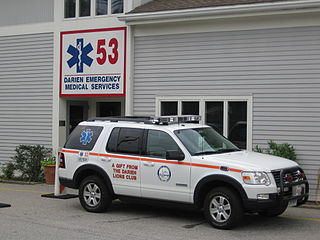Related Research Articles

Emergency medical services (EMS), also known as ambulance services or paramedic services, are emergency services that provide urgent pre-hospital treatment and stabilisation for serious illness and injuries and transport to definitive care. They may also be known as a first aid squad, FAST squad, emergency squad, ambulance squad, ambulance corps, life squad or by other initialisms such as EMAS or EMARS.

A paramedic is a health care professional whose primary role is to provide advanced emergency medical care for critical and emergent patients who access the emergency medical system.

A trauma center is a hospital equipped and staffed to provide care for patients suffering from major traumatic injuries such as falls, motor vehicle collisions, or gunshot wounds. A trauma center may also refer to an emergency department without the presence of specialized services to care for victims of major trauma.

Injury, also known as physical trauma, is damage to the body caused by external force. This may be caused by accidents, falls, hits, weapons, and other causes. Major trauma is injury that has the potential to cause prolonged disability or death. In 2013, 4.8 million people world-wide died from injuries, up from 4.3 million in 1990. More than 30% of these deaths were transport-related injuries. In 2013, 367,000 children under the age of five died from injuries, down from 766,000 in 1990. Injuries are the cause of 9% of all deaths, and are the sixth-leading cause of death in the world.

In the United States Armed Forces, the Combat Medic/Healthcare Specialist is responsible for providing emergency medical treatment at a point of wounding in a combat or training environment, as well as primary care, and health protection and evacuation from a point of injury or illness. Additionally, medics may also be responsible for the creation, oversight, and execution of long-term patient care plans in consultation with- or in the absence of a readily available physician or advanced practice provider. Combat medics may be utilized in hospitals and clinics where they have the opportunity to work in additional roles such as operating medical and laboratory equipment, performing and assisting with procedures, and beyond.

ABC and its variations are initialism mnemonics for essential steps used by both medical professionals and lay persons when dealing with a patient. In its original form it stands for Airway, Breathing, and Circulation. The protocol was originally developed as a memory aid for rescuers performing cardiopulmonary resuscitation, and the most widely known use of the initialism is in the care of the unconscious or unresponsive patient, although it is also used as a reminder of the priorities for assessment and treatment of patients in many acute medical and trauma situations, from first-aid to hospital medical treatment. Airway, breathing, and circulation are all vital for life, and each is required, in that order, for the next to be effective. Since its development, the mnemonic has been extended and modified to fit the different areas in which it is used, with different versions changing the meaning of letters or adding other letters.

In the United States, the paramedic is a professional whose primary focus is to provide advanced emergency medical care for critical and emergency patients who access Emergency Medical Services (EMS). This individual possesses the complex knowledge and skills necessary to provide patient care and transportation. Paramedics function as part of a comprehensive EMS response, under medical oversight. Paramedics perform interventions with the basic and advanced equipment typically found on an ambulance. The paramedic is a link from the scene into the health care system. One of the eligibility requirements for state certification or licensure requires successful completion of a nationally accredited Paramedic program at the certificate or associate degree level. Each state varies in requirements to practice as a paramedic, and not all states require licensure.
Ottawa Paramedic Service is a uniformed municipal public safety agency providing emergency and non-emergency paramedic care to residents and visitors of city of Ottawa, Ontario. It is the sole, licensed, statutory provider and is operated directly by the city. The Service is an independent third service provider. This means that it is part of the Emergency and Protective Services department of the city but functions as an independent and separate agency from other services. The Ottawa Paramedic Service operates in compliance with legislation and licensing standards overseen by the government of Ontario. It also provides routine, non-emergency transports and emergency paramedic coverage for special events. It is the only service provider permitted to service medical emergency calls in the City of Ottawa.

In the United States, emergency medical services (EMS) provide out-of-hospital acute medical care and/or transport to definitive care for those in need. They are regulated at the most basic level by the National Highway Traffic Safety Administration, which sets the minimum standards that all states' EMS providers must meet, and regulated more strictly by individual state governments, which often require higher standards from the services they oversee.
Cardiopulmonary resuscitation, also known by the acronym CPR, is an emergency procedure performed in an effort to manually preserve intact brain function by maintaining adequate perfusion of tissue until further measures are taken to restore spontaneous blood circulation and breathing in a person who is in cardiac arrest. CPR is a fundamental component of first aid that is practiced across the world. It is an effective method of keeping a victim of cardiac arrest alive long enough for definitive treatment to be delivered, usually through defibrillation and administration of intravenous drugs such as epinephrine and amiodarone.

R Adams Cowley was an American surgeon considered a pioneer in emergency medicine and the treatment of shock trauma. Called the "Father of Trauma Medicine", he was the founder of the United States' first trauma center at the University of Maryland in 1958, after the US Army awarded him $100,000 to study shock in people—the first award of its kind in the United States. The trauma unit at first consisted of two beds, and was later expanded to four beds. Many people called the four-bed unit the "death lab." Cowley was the creator of the "Golden Hour" concept, the period of 60 minutes or less following injury when immediate definitive care is crucial to a trauma patient's survival. He was a leader in the use of helicopters for medical evacuations of civilians, beginning in 1969, and founded the Society of Thoracic Surgeons. He also founded the nation's first statewide EMS system, called MIEMSS by Executive Order of Maryland's Governor Mandel, 1972, as well as the National Study Center for Trauma and EMS, enacted by Congress in 1986 and signed into law by President Ronald Reagan. He is also known for being one of the first surgeons to perform open-heart surgery and invented both a surgical clamp that bears his name and a prototype pacemaker that was used by Dwight D. Eisenhower.

The history of the ambulance begins in ancient times, with the use of carts to transport patients. Ambulances were first used for emergency transport in 1487 by the Spanish forces during the siege of Málaga by the Catholic monarchs against the Emirate of Granada, and civilian variants were put into operation in the 1830s. Advances in technology throughout the 19th and 20th centuries led to the modern self-powered ambulances.
The following outline is provided as an overview of and topical guide to emergency medicine:
The Emergency Medical Services for Children (EMSC) program is a US federal government health initiative. It is administered by the U.S. Department of Health and Human Services’ Health Resources and Services Administration (HRSA), and the Maternal and Child Health Bureau (MCHB). Its aim is to reduce child and youth disability and death due to severe illness or injury by increasing awareness among health professionals, provider and planners and the general public of the special needs of children receiving emergency medical care.

Healthcare in Belgium is composed of three parts. Firstly there is a primarily publicly funded healthcare and social security service run by the federal government, which organises and regulates healthcare; independent private/public practitioners, university/semi-private hospitals and care institutions. There are a few private hospitals. Secondly is the insurance coverage provided for patients. Finally, industry coverage; which covers the production and distribution of healthcare products for research and development. The primary aspect of this research is done in universities and hospitals.

Air medical services is a comprehensive term covering the use of air transportation, aeroplane or helicopter, to move patients to and from healthcare facilities and accident scenes. Personnel provide comprehensive prehospital and emergency and critical care to all types of patients during aeromedical evacuation or rescue operations aboard helicopter and propeller aircraft or jet aircraft.

Children's Healthcare Is a Legal Duty (CHILD) is an American nonprofit membership organization that works to stop child abuse and neglect based on religious beliefs, cultural traditions, and quackery. CHILD opposes religious exemptions from child health and safety laws. These exemptions have been used as a defense in criminal cases when parents have withheld lifesaving medical care on religious grounds. These exemptions also have discouraged reporting and investigation of religion-based medical neglect of children and spawned many outbreaks of vaccine-preventable diseases and deaths. CHILD publicizes the ideological abuse and neglect of children, lobbies for equal protection laws for children, and files lawsuits and amicus curiae briefs in related cases.
Emergency medicine reform in Ukraine has been part of Ukraine's healthcare reform program, launched in 2016. Managed by the Ministry of Healthcare of Ukraine, the program is meant to improve the quality and speed of Ukraine's emergency medical care.
Freedom House Ambulance Service was the first emergency medical service in the United States to be staffed by paramedics with medical training beyond basic first aid. Founded in 1967 to serve the predominantly black Hill District of Pittsburgh, Pennsylvania, the majority of its staff were African-American. Freedom House Ambulance Service broke medical ground by training its personnel to previously unheard of standards of emergency medical care for patients en route to hospitals. The paramedic training and ambulance design standards pioneered in the Freedom House Ambulance Service would set the standard for emergency care nationally and even internationally. Despite its successes, the ambulance service was closed eight years after it began operating.

Peter John Firth Baskett (1934–2008) was an Northern Irish physician, specializing in anaesthesia. He was responsible for the introduction of paramedics into the United Kingdom, created specialist ambulances for delivering on-scene pain relief to patients, and was the first chairman of the European Resuscitation Council.
References
- ↑ Howard, John M. (October 2000). "Special Contributions. Historical background to accidental death and disability: The neglected disease of modern society". Prehospital Emergency Care . 4 (4): 285–289. doi:10.1080/10903120090940958 . Retrieved 3 November 2014.
- ↑ Division of Medical Sciences, Committee on Trauma and Committee on Shock (September 1966), Accidental Death and Disability: The Neglected Disease of Modern Society, Washington, D.C.: National Academy of Sciences-National Research Council